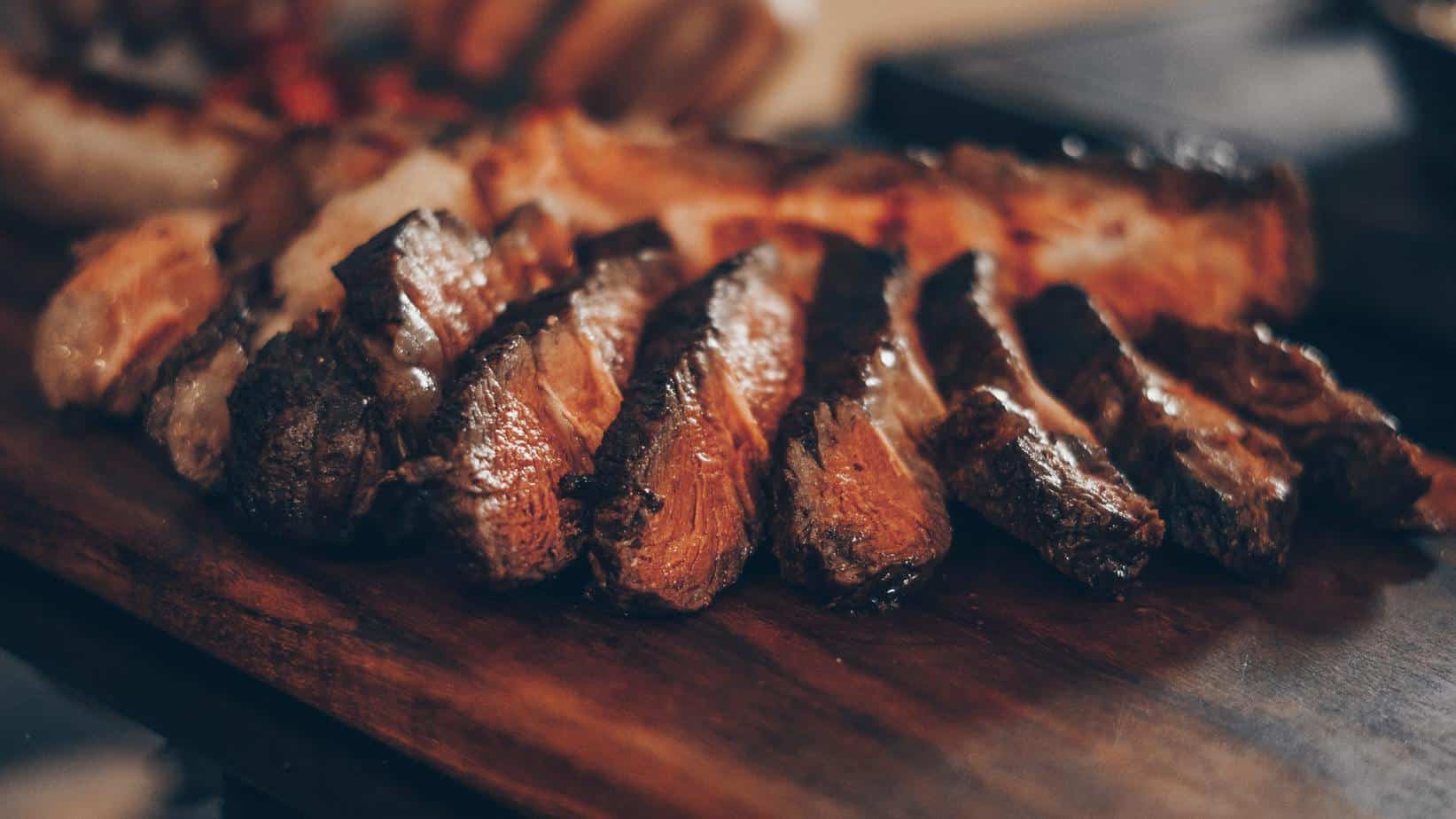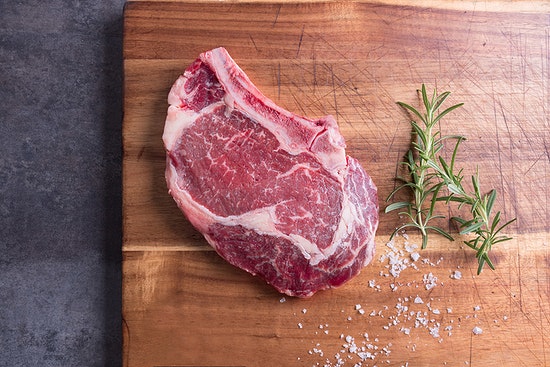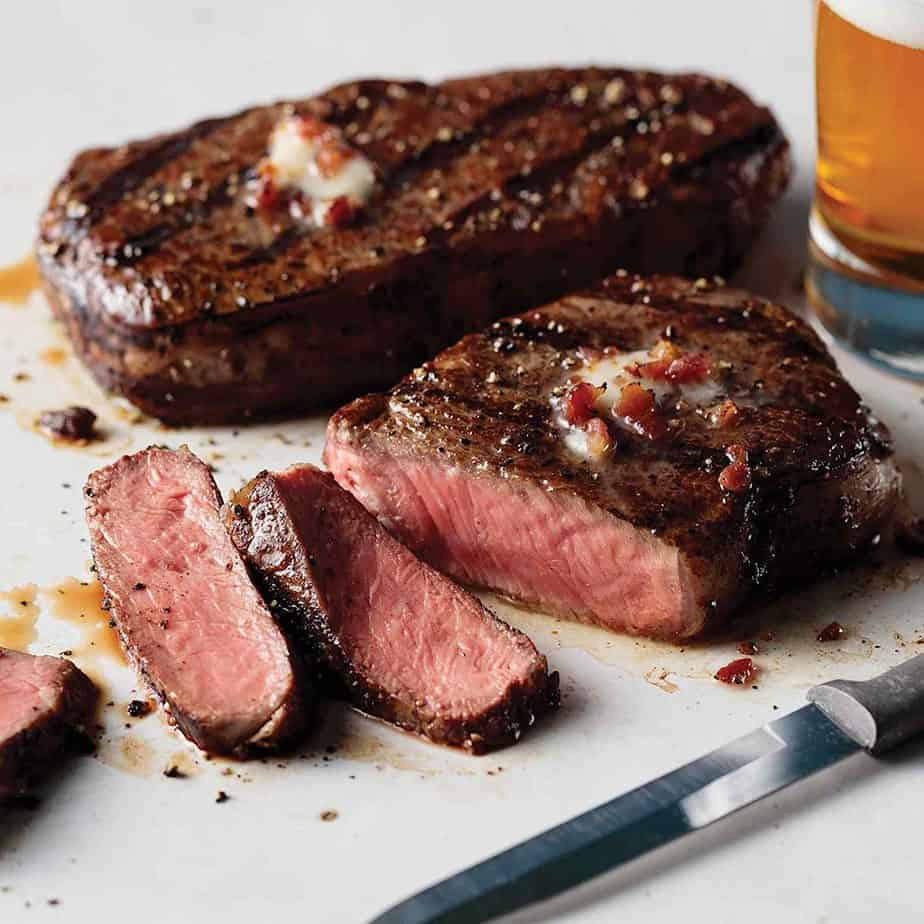- FarmFoods Market Review: Quality Meats? - April 12, 2023
- Rastelli’s Review: Is Their Meat Delivery Service Worth It? - April 12, 2023
- Porter Road Review: Pros and Cons - April 12, 2023
If you’re new here, let me start out by saying that not all steak is the same. You can’t just expect any steak to turn out tender and juicy just by tossing it on the grill for a few minutes. You have to really know how to treat it right.
Prime rib and ribeye are two superior cuts that you can count on to deliver excellent flavor, but you still have to know how to season it and which way to cook it in order to draw out the natural qualities of the meat.
Holy Grail partners are focused on the Holy Trinity of breeding, feeding and husbandry. They expertly-curated portfolio represents the spectrum of steak, from tender grass-fed Angus to an unparalleled array of A5 Japanese Wagyu beef.
These two cuts have a lot in common, but you’ll be surprised at some of their differences, too.
Main Differences Between Prime Rib and Ribeye
The main differences between prime rib and ribeye are:
- The prime rib is a large primal cut of beef, whereas the ribeye is a smaller section taken from between the sixth and twelfth rib.
- The prime rib contains a lot of fat and connective tissue making it very juicy and tender, whereas the ribeye contains a moderate amount.
- The prime rib is more commonly roasted, whereas the ribeye is usually grilled.
- The prime rib more expensive per unit but cheaper per pound, whereas the ribeye is more expensive per pound.
- Prime rib is best served at rare to medium-rare, whereas the ribeye is very forgiving and can be cooked up to medium-well.

Prime Rib
Prime rib is a large, beef rib roasting joint. It’s a bone-in, primal cut taken from the beef carcass, meaning it’s the large section of rib that they take other, smaller cuts from. Ribeye, tenderloin, and filet mignon are cuts that also come from this section.
Prime rib is also known as beef rib roast or standing rib roast. It’s a very large section of meat meant for roasting rather than grilling or searing, although you can grill or sear the outer edges before roasting if you like.
The term standing rib roast comes from how it’s most often roasted with the ribs stacked vertically. This allows the flavors from the fat cap to flow downward through the entire joint when cooking.
Appearance
The prime rib is a large section of meat surrounding the rib. It’s a bone-in cut that still contains the ribs, muscle, and fat surrounding it. It’s marbled elegantly throughout with a large section of fat at one end.
Texture
The prime rib is a large cut of beef. Its texture varies throughout. It has a thin layer of skin across the top, covering the ribs, with marbling throughout. It also has a decent amount of fat, making it tender and juicy. It’s a popular cut to use in au jus.

Taste
The prime rib has a very rich, pronounced, meaty flavor. The presence of bone, connective tissue, and fat make that flavor stronger than other cuts that have less of these. Roasting as a method of cooking also tends to preserve these flavors better than grilling.
Cost
Prime rib generally costs quite a bit, but that’s because it’s a very large chunk of meat. You’ll pay less per pound buying it this way than you will many other cuts of meat. However, if you don’t have room to roast that much meat, it may not be worth the savings.
On the other hand, if you are feeding a large family for the holidays, it’s well worth paying a few hundred dollars for a large cut that will feel everyone when roasted to perfection.
Portion size
If you’re purchasing a large portion of prime rib from the butcher, you’re likely going to get at least four pounds at a time. You could get as many as eight pounds or more, depending on how big the section was cut.
If you’re ordering prime rib at a restaurant, you’ll be able to get it in much smaller sections because it’s much easier for a restaurant to roast a large portion of meat and then slice it into smaller sections and serve it up.
Cooking a prime rib
Prime rib is generally roasted rather than grilled. It’s roasted slowly at a very low temperature until the meat is 130-140°F.
Depending on your personal preferences, there are plenty of ways you can season it. You can use dry rubs or marinades, and you can use a lot of different techniques for roasting. There are even many different recipes that involve other ingredients in the roast to add flavors.
However, the most common technique is to sear the outside of the prime rib before roasting at 200°F for about five hours.
A prime rib tastes excellent anywhere from rare to medium-rare. It shouldn’t be cooked any longer than that or the fat will melt off, leaving the meat dry, tough, and chewy.
Pros
- Tender and juicy
- Flavorful
- Pairs well with many other foods
- Affordable
Cons
- Can be hard to cook due to large size
Ribeye
The ribeye’s name comes from the section of beef from where it’s cut and the way it looks. It’s taken from the rib and it has a swirl of fat that marbles in the shape of an eye in the middle of the meat. Sometimes it has a bone and sometimes it doesn’t, depending on how the butcher cuts it.
This cut comes from the same section as the prime rib, but rather than cooking it as a whole roast, it’s cut into separate steaks and grilled.
Just like some cuts contain a bone and some don’t, each ribeye can contain a different muscle, depending on how they’re cut. Some have dorsal, long, or spinal muscles. They’re a mixture of tender and tough meat with excellent fat content and marbling to give them great juicy flavor.
The ribeye has so much fantastic natural flavor that it needs a very little seasoning. Just a little salt and pepper is enough to bring out the flavors on the grill, and it’s one of steak lover’s favorite cuts.
Appearance
The ribeye is cut between 8 and 12 ounces and is typically an inch or an inch and a half thick. It’s marbled with fat and tissues, which contributes to its great flavor, and if it’s grilled properly, it’s not chewy or hard to eat.
In addition to the white fat throughout, you’ll also see strips of fat around the edges.

Texture
Fat does interesting things to meat. Fat is chewy, but depending upon the fat content, how it’s distributed, and how it’s cooked, it can make the steak very tender. The ribeye is a great example of this.
When cooked correctly, the fat in the ribeye lends plenty of flavors and makes the steak very juicy and tender. It’s not quite as tender as a filet mignon, but it offers a great balance between flavor and texture.
Taste
Ribeyes are very meaty. This is a well-exercised muscle, so it’s had time to develop more taste. It’s strong, rich, and fleshy, dominating everything else on the plate.
You can still serve it with plenty of other flavorful foods, but the flavors should complement each other rather them compete for attention on the plate.
Cost
Ribeye is pleasantly affordable. While it’s not the cheapest cut, you’ll find great value in its tenderness and flavor. You’re definitely getting your money’s worth here.
Portion size
Most restaurants will serve ribeye steaks between 8 and 12 ounces. It’s hearty and filling, so you don’t need a lot of sides to go with it. You may even want to err on the side of caution and order the smaller size if you want to save room for dessert.
Grilling prep
A ribeye should never be thinner than one inch. 1.5 inches is even better. It will cook up better, have a better mouthfeel, and the flavor will be more intense. Don’t trim the fat off unless there’s a protrusion that you fear will char.
Let the steak rest on the counter for at least 30 minutes, if not an hour before cooking. This takes the chill off, which allows the steak to cook more evenly, preserving the flavor and preventing a loss of juice.
There’s no reason to add any flavor to your ribeye unless you just want to. Salt and pepper is plenty to draw out the natural flavors of the meat. However, if you want a little something extra, you can use a dry rub.

Cooking a ribeye
Cooking a ribeye requires a two-zone cooking space. Turn one burner to medium-high heat, or slide your coals over to one side of the grill. Turn the other burner on low. This makes one side of your grill hot and the other cooler.
Once your hot side is, well, hot, place your ribeye directly over the heat. Sear them for 4-5 minutes on each side. If you like your steak medium-rare, you can pull them off and let them sit for 5 minutes. The carryover cooking will pink them up nicely for you.
If you like them a bit more done, move your steak to the cooler side of the grill so you can allow them to finish cooking without burning the exterior.
The excess fat on a ribeye will catch fire more easily than less fatty steaks, so make sure you monitor your ribeyes closely to prevent flare-ups.
Pros
- Hearty and flavorful
- Beautiful marbling
- Inexpensive
Cons
- Fat content can cause flare-ups
- Can be fatty and chewy
Comparison Chart
| Prime Rib | Ribeye | |
| Size | Large | Medium to large |
| Meat content | High | High |
| Fat content | Moderate to high | Moderate to high |
| Weight | 4-8 pounds | 8-12 ounces |
| Servings per cut | 12-16 | 2 |
| Location on cow | Ribs | Upper central ribs |
| Calories (3oz serving) | 290 | 170 |
| Saturated fat (3oz serving) | 9.3 grams | 2.8 grams |
| Protein (3oz serving) | 19.2 grams | 26 grams |
| Iron (3oz serving) | 2.1 mg | 3 mg |
FAQ
While prime rib and ribeye are very similar, it can be confusing trying to understand the difference. Here are some frequently asked questions about prime rib and ribeye to help set the record straight.
Which is better, ribeye or prime rib?
Prime rib is a bigger cut of meat that will feed more people, and it still contains the ribeye area, too. Plus, cooking with the bone in keeps the meat more tender and juicy. However, keep in mind that some ribeyes are cut with the bone in, so you can enjoy a smaller cut of excellent meat.
Is prime rib better than steak?
It all comes down to how you like your meat cooked. If you’re comparing the prime rib to a sirloin, porterhouse, or strip, the prime rib is much more tender while still offering the meaty flavor you love.
However, many steak enthusiasts enjoy the taste of a steak fresh off the grill, and if that’s the case, you’ll want to opt for a steak. You can choose a ribeye for that same great prime rib flavor in the form of a steak.
Why is prime rib served rare?
You should never cook prime rib past medium, but it’s best at rare or medium-rare. That’s because if you cook meat like prime rib for too long, the fat will melt out, which leaves the meat dry, tough, and chewy.
Which is Better?
If you prefer your steak on the grill, you’ll want to opt for the ribeye. It’s tender and juicy with rich and hearty meat flavor. It’s part of the prime rib cut, so you’re getting some of the best of the prime rib in a smaller, more manageable cut.
Not to mention, it’s a forgiving piece, so if you grill it just a bit too much, it will still taste delicious. Because it has so much natural flavor, you won’t need to season it much, but you still can if you’d like to.
If you’re up for the challenge, get a prime rib, and try your luck. It’s not hard, but it does take a lot of room and a bit of finesse. These large cuts are best roasted at low temperatures for several hours.
You can rub them with your favorite seasonings, and it’s common to sear the outside before roasting. It’s incredibly tender and delicious and great with vegetables and potatoes as well as in a sandwich with the au jus from your roasting pan.
Holy Grail partners are focused on the Holy Trinity of breeding, feeding and husbandry. They expertly-curated portfolio represents the spectrum of steak, from tender grass-fed Angus to an unparalleled array of A5 Japanese Wagyu beef.


